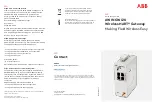
Prestige 792H User’s Guide
14-14
VPN
Screens
Choose a Diffie-Hellman public-key cryptography key group (
DH1
or
DH2
)
.
Set the IKE SA lifetime. This field allows you to determine how long an IKE SA should stay up before it
times out. An IKE SA times out when the IKE SA lifetime period expires. If an IKE SA times out when
an IPSec SA is already established, the IPSec SA stays connected.
In phase 2 you must:
Choose which protocol to use (
ESP
or
AH
) for the IKE key exchange.
Choose an encryption algorithm.
Choose an authentication algorithm
Choose whether to enable Perfect Forward Secrecy (PFS) using Diffie-Hellman public-key cryptography
– see
section 14.10.3
. Select
None
(the default) to disable PFS.
Choose
Tunnel
mode or
Transport
mode.
Set the IPSec SA lifetime. This field allows you to determine how long the IPSec SA should stay up
before it times out. The Prestige automatically renegotiates the IPSec SA if there is traffic when the
IPSec SA lifetime period expires. The Prestige also automatically renegotiates the IPSec SA if both
IPSec routers have keep alive enabled, even if there is no traffic. If an IPSec SA times out, then the
IPSec router must renegotiate the SA the next time someone attempts to send traffic.
14.10.1 Negotiation
Mode
The phase 1
Negotiation Mode
you select determines how the Security Association (SA) will be established
for each connection through IKE negotiations.
Main Mode
ensures the highest level of security when the communicating parties are negotiating
authentication (phase 1). It uses 6 messages in three round trips: SA negotiation, Diffie-Hellman
exchange and an exchange of nonces (a nonce is a random number). This mode features identity
protection (your identity is not revealed in the negotiation).
Aggressive Mode
is quicker than
Main Mode
because it eliminates several steps when the
communicating parties are negotiating authentication (phase 1). However the trade-off is that faster
speed limits its negotiating power and it also does not provide identity protection. It is useful in remote
access situations where the address of the initiator is not know by the responder and both parties want to
use pre-shared key authentication.
14.10.2 Diffie-Hellman
(DH) Key Groups
Diffie-Hellman (DH) is a public-key cryptography protocol that allows two parties to establish a shared
secret over an unsecured communications channel. Diffie-Hellman is used within IKE SA setup to establish
session keys. 768-bit (Group 1 -
DH1
) and 1024-bit (Group 2 –
DH2
) Diffie-Hellman groups are supported.
Upon completion of the Diffie-Hellman exchange, the two peers have a shared secret, but the IKE SA is not
authenticated. For authentication, use pre-shared keys.
14.10.3
Perfect Forward Secrecy (PFS)
Enabling PFS means that the key is transient. The key is thrown away and replaced by a brand new key using
a new Diffie-Hellman exchange for each new IPSec SA setup. With PFS enabled, if one key is compromised,
Summary of Contents for Prestige 792H
Page 1: ...Prestige 792H G SHDSL 4 port Security Gateway User s Guide Version 3 40 BZ 0 March 2004...
Page 8: ......
Page 32: ......
Page 34: ......
Page 40: ......
Page 46: ......
Page 66: ......
Page 86: ...Prestige 792H User s Guide 5 14 WAN Setup Figure 5 6 Advanced WAN Backup...
Page 94: ......
Page 108: ......
Page 112: ......
Page 134: ......
Page 164: ......
Page 178: ...Prestige 792H User s Guide 14 8 VPN Screens Figure 14 3 VPN IKE...
Page 206: ......
Page 210: ......
Page 220: ......
Page 221: ...Maintenance VI Part VI Maintenance This part covers the maintenance screens...
Page 222: ......
Page 234: ......
Page 236: ......
Page 246: ......
Page 268: ......
Page 270: ......
Page 282: ......
Page 286: ......
Page 312: ......
Page 334: ......
Page 348: ......
Page 370: ......
Page 380: ......
Page 388: ......
Page 390: ......
Page 406: ......
Page 410: ......
Page 415: ...XI Part XI Appendices and Index This section provides some Appendices and an Index...
Page 416: ......
Page 420: ......
Page 424: ......
Page 426: ......
Page 430: ......
















































